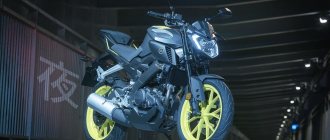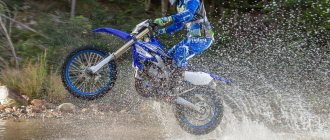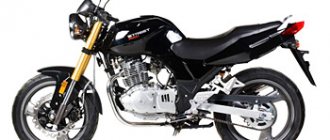Simplicity and reliability are the main advantages of this model. As for comfort, speed, directional stability and noise level, all this is clearly not at the highest level. The Yamaha CPX 400 is a simple motorcycle for those who love road bikes from the nineties and are inclined to ride on the streets rather than on windswept roads.
Despite its simplicity, the model demonstrates average characteristics for its time. A motorcycle, in principle, can even be used for traveling on a country road, but you must understand that the roar of the engine will sooner or later tire you, and this motorcycle will not ignore gusts of wind.
Engine
The engine of this bike is borrowed from the XT 400, a fairly old enduro. The engine now has an electric starter, but it has been deprived of a kickstarter. In addition, the power was slightly reduced - to 33 hp. Cooling here is air-oil. This allows the SRX 400 to accelerate to hundreds in just over six seconds and reach a top speed of 140 km/h. But it is worth considering that when crossing the threshold of 110 km/h, the motorcycle begins to roar too much and vibrations that are unpleasant for the motorcyclist appear.
Yamaha SRX 400 motorcycle review
Design
Of course, there is nothing flashy or super fashionable, just a classic look. In combination with driving performance it goes well, in my opinion.
Comfort
With my height (more than 190 cm), at first my legs felt numb, and even now it’s the same during long trips. At the same time, you don’t feel tired in your back. The absence of a windshield on the srx 400, in principle, does not affect anything in this model. It handles easily, almost like a bicycle. And its weight, I tell you, is not heavy at all - about 130 kg. The most suitable speed for me on it is up to one hundred.
Safety.
What can I say - all motorcycles are dangerous as soon as you sit on them)) Seriously, this indicator is a solid “B”. It often forgives minor mistakes; when you don’t notice a lying policeman, it won’t throw you off the saddle. But I wouldn’t recommend being particularly reckless or careless.
Reliability.
Here I will say on emotions - I don’t-have-a-bi-va-eat a motorcycle! It’s even difficult to imagine how it needs to be destroyed so that parts or mechanisms begin to break. There are not many horses, but enough for a 400cc enduro engine. All this creates a decent amount of traction, and the resource increases significantly - I recommend checking it out from personal experience. An air-oil cooling system is installed - a fact is a fact, although in Moscow traffic jams it’s not exactly what is needed.
Among the things I'm not happy with: the rear spring is too soft. Gear shifting is also a bit difficult. But in this I make allowance for the significant age and mileage of the moto.
Driving characteristics of Yamaha SRX400
I tested them not only in my town and the capital, but also traveled a lot during the season - regular forays into nature, along dirt and country roads. That's when I really enjoyed traveling. Motz has excellent road holding and balance, but of course he didn’t risk getting into obvious swamps and sand dunes.
The tank is designed for 14 liters, the consumption is very small. I didn’t skimp on gasoline; I filled it with 95 for reliability and confidence. The maximum speed for this modification is 130 km/h, which is clearly an unnecessary limit. In general, after a hundred dynamics are lost, it is clear that speed is not exactly its advantage.
To summarize the advantages: the Yamaha srx400 has no problems with reliability, fuel consumption is low, the device is lightweight, and it’s not difficult to pull it out of the swamp and lift it. All advantages are completed by low cost, even for a student. Of course, with time and experience you begin to want to ride at higher speeds, and the low weight on the track turns into a disadvantage. That's all. Start with this, I advise.
I took my Yamaha SRX400 almost antique - 1989. Of course, due to the low cost. Time and the previous owners have taken a beating on the device. I replaced a lot of things at once, the rest gradually. I immediately decided to dig up information on the forums about the Yamaha SRX 400, and compiled a list of the main problems. I took the same parts as for the 600 - they fit perfectly, are easier to find, and therefore the price is lower. I recommend not delaying the installation of the sprocket-chain kit, only after that start running it in full.
Although it is ancient, I like the design, nothing superfluous, classic. The single-cylinder enduro engine is reliable and will endure a lot without complaining or chugging. The gearbox is more problematic, but I attribute this to old age. The engine corrects all shortcomings by smooth operation. Thirty-three horses is not enough, of course, but it’s enough for a horse with such a light weight.
I wouldn’t say that I’m gluttonous in terms of oil - it takes about 100 ml per km - you agree, quite a bit. The chassis is designed for quiet driving, the braking system is also not for extreme sports. However, I am still not disappointed with the handling of the SRX 400. And in traffic jams, I haven’t seen a better stitcher. Benz also doesn’t take much - about five liters. But for lovers of tracks, overtaking and speed, this is definitely not an option. For all the time it broke in one place - it broke the gasket, the one under the cylinder. If you want a reliable companion for daily driving around the city and to the country, don’t think about it!
Dimensions and weight
Weight of 170 kg including fuel is a fairly typical figure for this type of bike of that time. Especially when you consider that the gas tank volume is 15 liters. The motorcycle is small: the seat height is 760 mm, while the wheelbase is only 1425 mm.
Brief history of the model
- 1993 – start of production and sales of Yamaha XJR 400. First generation.
Frame number –
4HM-0XXXXX
. - 1996 - the model is visually distinguished by gold Brembo calipers. Second generation
.
The letter R is added to the name of the motorcycle - Yamaha XJR400R. Frame number – 4HM-05XXXX
,
4HM-11XXXX
,
4HM-10XXXX
. - 1998 – The design of the dashboard changes. Third generation
.
At Japanese auctions it is designated as – Yamaha XJR400R-2
.
Frame number – 4HM-11XXXX
,
4HM-12XXXX
. - 2001 - the model is visually distinguished by Nissin Sumitomo brake calipers from the Yamaha YZF-R1. Fourth generation
.
At Japanese auctions it is designated as Yamaha XJR400R-3
.
Frame number – RH02J-XXXXXX
. - 2009 is the last year of sales of the Yamaha XJR 400.
Chassis and brakes
The suspension here is unremarkable: a typical swingarm with a shock absorber at the rear, and again a typical telescopic fork at the front. Another thing is the brakes. If the rear is represented by a very symbolic disc with a single-piston caliper and is auxiliary, then the front has a 320 mm disc, and the caliper here is already two-piston.
As for the exterior, it is gorgeous in its own way. Yes, it may not be distinguished by the luxury of its forms, but its classicism and abundance of chrome cannot go unnoticed. The motorcycle seems frozen at the turn of the century and represents the road class of the nineties.
Manufacturer country
was founded in 1887 in Japan. The main specialization was the development and production of musical instruments. Almost seventy years later, the company was divided into two. The first one also continued to produce tools, and the second one received a fundamentally new direction - the production of motor vehicles. Yamaha Motors was destined to become a world famous corporation.
First motorcycle
In 1955, the manufacturer's first motorcycle, the YA-1, rolled off the assembly line. At that time, design engineers only had aircraft manufacturing machines at their disposal. But this did not stop us from making a reliable and powerful device that won local races. The new motorcycle became the best advertisement for Yamaha Motors.
People all over the world are accustomed to trusting technology made in Japan. At the beginning of the 20th century, it was a technically backward country, but in a couple of decades it caught up. Likewise, the company’s employees, following the best traditions, were constantly looking for new production methods and improving existing ones. Every year, the staff was replenished with highly qualified employees, thanks to this, fifteen years later it was possible to move to a new level of production.
In 1970, the company began producing motorcycles with four-stroke engines.
First snowmobile
Following the success in the motorcycle market, management decided to start producing other oversized vehicles - scooters, mopeds, and jet skis. The first snowmobile appeared in 1968 - it was the Yamaha SL350 model.
Competitors (Comparison)
Both the manufacturer and users believe that in the retro series only one model can be compared with the Yamaha model: This is the Honda CL 400, and then the Honda CB400SS.
But both models have some differences.
In particular, the first one does not have a tachometer. Everything else is identical. It was produced for only 3 years from 1998 to 2000. It was replaced by the Honda CB400SS. She got a tachometer, but the decompressor disappeared. And the main difference was the appearance of an electric starter (the foot remained).
In detail - 4-valve engine, carburetor, 3 more powerful. It seems that fuel consumption is half as much.
But also discontinued.
In 2006, the model received a new competitor. Kawasaki tried to enter the retro niche. Their Kawasaki W400 had 2 cylinders, 29 horsepower and achieved the best performance already at 7x1000. The stock model had kick and electric start. Tightening environmental regulations for Japan in 2008 proved fatal for the bike. Production is closed.
Brief history of the model
Model
: Yamaha SR400 (Japan).
Factory designation
: 2H60.
1983 - no significant changes.
Model
: Yamaha SR400 (Japan).
Factory designation
: 34F.
1984 - no significant changes.
Model
: Yamaha SR400 (Japan).
Factory designation
: 34F.
1985 - the model receives a drum front brake and an 18′ front wheel.
Model
: Yamaha SR400 (Japan).
Factory designation
: 1JR0.
1992 - no significant changes.
Model
: Yamaha SR400S;
Yamaha SR400C (Japan). Factory designation
: 3HT4; 3HT3.
1993 - no significant changes.
Model
: Yamaha SR400 (Japan).
Factory designation
: 3HT5.
1994 - no significant changes.
Model
: Yamaha SR400 (Japan).
Factory designation
: 3HT6.
1995 - no significant changes.
Model
: Yamaha SR400S (Japan).
Factory designation
: 3HT7.
1997 - no significant changes.
Model
: Yamaha SR400 (Japan).
Factory designation
: 3HT8.
1998 - no significant changes.
Model
: Yamaha SR400 (Japan).
Factory designation
: 3HT9.
1999 - no significant changes.
Model
: Yamaha SR400 (Japan).
Factory designation
: 3HTA.
2000 - no significant changes.
Model
: Yamaha SR400 (Japan).
Factory designation
: 3HTB.
2001 - The model returns to a disc front brake and receives exhaust updates to meet new environmental standards.
Model
: Yamaha SR400 (Japan).
Factory designation
: 3HTC.
2002 - no significant changes.
Model
: Yamaha SR400 (Japan).
Factory designation
: 3HTE; 3HTD.
2003 - no significant changes.
Model
: Yamaha SR400 (Japan).
Factory designation
: 3HTH, 3HTG, 3HTF.
2004 - no significant changes.
Model
: Yamaha SR400 (Japan).
Factory designation
: 3HTJ.
2005 - no significant changes.
Model
: Yamaha SR400 (Japan).
Factory designation
: 3HTK, 3HTL.
2006 - no significant changes.
Model
: Yamaha SR400 (Japan).
Factory designation
: 3HTN, 3HTM.
2007 - no significant changes.
Model
: Yamaha SR400 (Japan).
Factory designation
: 3HTP.
2008 - no significant changes.
Model
: Yamaha SR400 (Japan).
Factory designation
: 3HTS.
2010 - due to the introduction of new environmental standards, the model is equipped with an injector.
Model
: Yamaha SR400 (Japan).
Factory designation
: 3HTR.
2012 - no significant changes.
Model
: Yamaha SR400 (Japan).
Factory designation
: 3HTU.
2013 - no significant changes.
Model
: Yamaha SR400 (Japan).
Factory designation
: 3HTV.
2014 - no significant changes.
Model
: Yamaha SR400 (Japan, Europe).
Factory designation
: 3HTW, 2RD1.
2015 - no significant changes.
Model
: Yamaha SR400 (North America).
Factory designation
: 2RD2, 2RD3.
2016 - no significant changes.
Model
: Yamaha SR400 (Japan, Europe, North America).
Factory designation
: 3HTY, 3HTX, 2RDB.
2017 - no significant changes.
Model
: Yamaha SR400 (Japan, North America).
Factory designation
: B0H1, 2RDE, 2RDD.
2018 - no significant changes.
Model
: Yamaha SR400 (Japan, North America).
2019 - no significant changes.
Model
: Yamaha SR400 (Japan).









